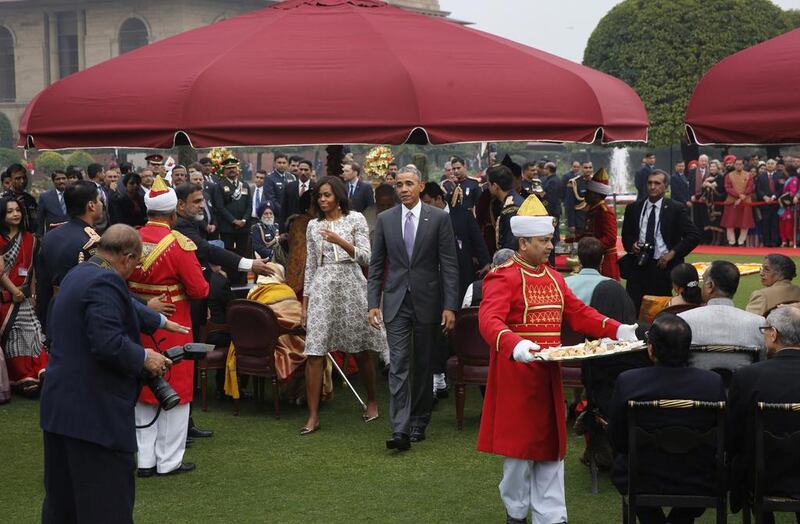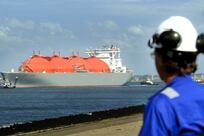NEW DELHI // India held its annual Republic Day parade on Monday, showcasing its military strength and cultural diversity to US president Barack Obama, the chief guest at this year’s event.
A series of floats and military tanks rolled down the Rajpath, in the heart of Delhi, as Mr Obama sat with prime minister Narendra Modi in a bulletproof enclosure. Army regiments marched in full regalia; brass bands struck up a medley of songs; border guards rode camels; and fighter jets screamed in formation overhead.
Republic Day marks the anniversary of India’s adoption of its constitution, in 1950. The first such parade took place that very year.
Following tradition, the parade route ran through Rajpath, a ceremonial avenue built by the British during colonial times. As happens nearly every year, there was intermittent rain during the parade. Bodyguards stood behind Mr Modi and Mr Obama, holding umbrellas over the two leaders.
Security was tight across the city and particularly around Rajpath. Snipers occupied nearby rooftops, and thousands of plainclothes and uniformed security personnel were spread over the area.
The cultural segment of the parade involved more than 30 floats, built to represent the unique characteristics of every Indian state.
But the focus of the event — and the deeper symbolism of the day — lay in the array of military technology that was put on display to Mr Obama, the first US president to ever be a chief guest at the Republic Day parade.
The aircraft were Russian MI-35 helicopters and MiG and Sukhoi jets. The tanks were T-90s, also of Russian make.
For years, Russia was the biggest exporter of arms to India, having notched up a total of over US$40 billion (Dh146.9bn) in defence sales since India’s independence.
But, over the last three years, the United States has knocked Russia off the top spot.
India, the world’s largest importer of arms and armaments, imported 834 billion rupees (Dh49.77bn) worth’ of equipment between 2011 and 2014.
More than a third of that came from the US, surpassing Russian imports by 7.3 billion rupees. In media reports, analysts have estimated that India will spend around $250 billion in arms imports over the next decade.
The US has recognised the prime market that India has become for its military contractors.
On Mr Obama’s trip, which began on Sunday, India and the US renewed a 10-year defence pact and made plans to work together in producing aircraft carriers, jet engines and surveillance drones.
Geopolitically, empowering India in this manner is a smart move for the US, Bharath Gopalaswamy — the Washington-based acting director of the South Asia Center — wrote on Monday, in a Reuters op-ed co-authored with former US ambassador to Beijing Jon Huntsman.
“The larger goal that the United States should be pursuing here is to convince India to join a coalition of democracies to balance China’s rise,” Mr Gopalaswamy and Mr Huntsman wrote. “Although it won’t be publicised, this topic will likely be ever-present in their private conversations.”
After the parade, Mr Obama attended a reception at Rashtrapati Bhavan, the official residence of the Indian president Pranab Mukherjee.
He then met with leaders from the opposition Congress party and, in the evening, with a group of Indian and American business executives.
ssubramanian@thenational.ae





